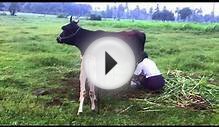Milk provides essential nutrients and is an important source of dietary energy, high-quality proteins and fats. Milk can make a significant contribution to the required nutrient intakes for calcium, magnesium, selenium, riboflavin, vitamin B12 and pantothenic acid. Milk and milk products are nutrient-dense foods and their consumption can add diversity to plant-based diets. Animal milk can play an important role in the diets of children in populations with very low fat intakes and limited access to other animal source foods.
The species of dairy animal, its breed, age and diet, along with the stage of lactation, parity (number of parturitions), farming system, physical environment and season influence the colour, flavour and composition of milk and allow the production of a variety of milk products:
- Cow milk: Fat constitutes approximately 3 to 4 percent of the solid content of cow milk, protein about 3.5 percent and lactose 5 percent, but the gross chemical composition of cow milk varies depending on the breed. For example, the fat content is usually higher in Bos indicus than B. taurus cattle. The fat content of milk from B. indicus cattle can be as much as 5.5 percent.
- Buffalo milkhas a very high fat content, which is on average twice as high as that of cow milk. The fat-to-protein ratio in buffalo milk is about 2:1. Compared with cattle milk, buffalo milk also has a higher casein-to-protein ratio. The high calcium content of casein facilitates cheese making.
- Camel milkhas a similar composition to cow milk but is slightly saltier. Camel milk can be three times as rich in vitamin C as cow milk and represents a vital source of this vitamin for people living in arid and semi-arid areas, who often cannot obtain vitamin C from fruits and vegetables. Camel milk is also rich in unsaturated fatty acids and B vitamins. Milk from Bactrian camels has a higher percentage of fat than milk from dromedaries, but levels of proteins and lactose are similar. Generally, camel milk is consumed raw or fermented.
- Sheep milk has higher fat and protein contents than goat and cow milk; only buffalo and yak milk contain more fat. Sheep milk also generally has a higher lactose content than milk from cows, buffaloes and goats. The high protein and overall solid contents of sheep milk make it particularly appropriate for cheese and yoghurt making. Milk from sheep is important in the Mediterranean region, where most of it is processed into cheeses such as pecorino, caciocavallo and feta.
- Goat milk has a similar composition to cow milk. In Mediterranean countries and in Latin America, goat milk is generally transformed into cheese; in Africa and South Asia, it is usually consumed raw or acidified.
- Yak milk tastes sweet and has a fragrant, sweetish smell. Yak milk has between 15 and 18 percent solid content, 5.5 to 9 percent fat and 4 to 5.9 percent protein. It therefore has higher solid, fat and protein contents than cow and goat milk, and resembles buffalo milk. Raw milk is used mainly by herders and their families in milky tea. Yak milk can be processed into a variety of milk products including butter, cheese and fermented milk products.
- Equine milk: Horse and donkey milk have very similar compositions. Equine milk, like human milk, is relatively low in proteins (particularly caseins) and ashes and rich in lactose. Compared with that of other dairy species, equine milk contains low levels of fat and protein. Most equine milk is consumed fermented and it is not suitable for cheese making.







